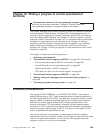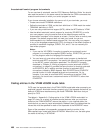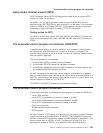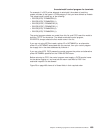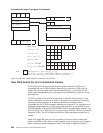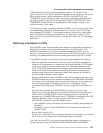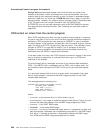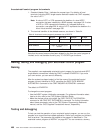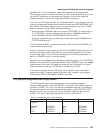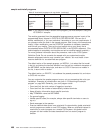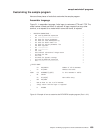before returning to CICS. If you need information about the formats and acceptable
character ranges for any of the return values, refer to the
CICS Resource Definition
Guide
.
If you are using MTS, then VTAM supplies the PRINTER and ALTPRINTER
NETNAMEs, if specified.
The printers need not be installed at this stage; however, they must be installed
before you use Print Key support. PRINTER and ALTPRINTER IDs override
PRINTER and ALTPRINTER NETNAMEs.
Note that TERMID, PRINTER, and ALTPRINTER are the only attributes of the
TERMINAL definition that can be set by the autoinstall control program; all other
attributes must come from one of these sources:
v The VTAM LOGMODE entry (MODEENT)
v The autoinstall model TERMINAL definition
v The TYPETERM definition that it refers to
v The QUERY function
v Model names from VTAM MDLTAB MDLENT and printers’ NETNAMEs from
VTAM ASLTAB ASLENT (if you are using MTS).
Notes:
1. The QUERY function overrides any extended attributes specified in the
TYPETERM definition.
2. You cannot override information in the LOGMODE entry, with the model
TERMINAL and TYPETERM; they must match.
If your control program decides to reject the INSTALL request, it should return to
CICS with a nonzero value in the return code.
Having completed processing, the control program must return to CICS by issuing
an EXEC CICS RETURN command.
Selecting the autoinstall model
If you are using model terminal support to supply the model name (and the named
model exists and is valid), CICS passes the model name to your autoinstall control
program—you do not need to make any further selection.
As a general rule, all the models in the list passed to your program match the
VTAM data for the terminal. That is, a viable TCT entry usually results from the use
of any of the models. (The exception to this rule involves the VTAM RUSIZE; if this
value is incompatible, CICS issues an error message.) The default autoinstall
control program merely picks the first model in the list. However, this model may not
provide the attributes required in all cases. For instance, you do not want a 3270
display device definition for a 3270 printer. Your control program must be able to
select the model that provides the characteristics you require for this terminal—for
example, security characteristics.
To save on storage, you should try to minimize the number of different models
available to the control program, and the number of different TYPETERM definitions
referenced by those models. If you are migrating your definitions from DFHTCT
macros, look carefully at them and eliminate those that are unnecessarily different
from others. Use the QUERY function for all devices that can support it. For
the autoinstall control program for terminals
492
CICS TS for OS/390: CICS Customization Guide




